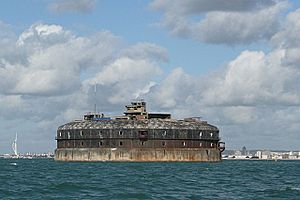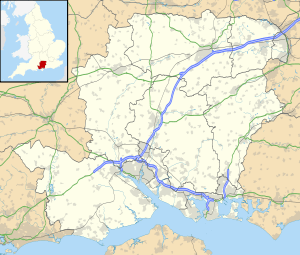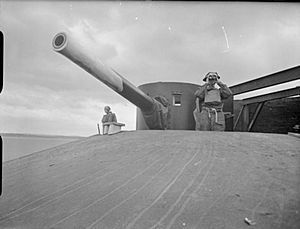Horse Sand Fort facts for kids
Quick facts for kids Horse Sand Fort |
|
|---|---|
| Solent, England | |

Horse Sand Fort
|
|
| Coordinates | 50°45′0.0″N 1°4′21.17″W / 50.750000°N 1.0725472°W |
| Type | Fort |
| Site information | |
| Owner | AmaZing Venues |
| Open to the public |
No |
| Official name | Horse Sand Fort |
| Designated | 12 June 1967 |
| Reference no. | 1018588 |
| Condition | Complete |
| Site history | |
| Built | 1865–1880 |
Horse Sand Fort is a huge sea fort located in the Solent, near Portsmouth, Hampshire, England. It is one of four "Palmerston Forts" built to protect the coast. This fort is about 61 meters (200 feet) wide. It was built between 1865 and 1880. It has two main floors, a basement, and was covered in strong armor.
Contents
History of Horse Sand Fort
Who Designed Horse Sand Fort?
Captain E. H. Stewart designed Horse Sand Fort. Colonel W. F. D. Jervois helped supervise the project. Building started in 1865 and finished in 1880. The fort cost about £424,694 to build. This was a lot of money back then!
What Was Inside the Fort?
The fort was originally planned to hold many large guns. It was meant to have 45 10-inch guns and 44 12.5-inch guns. These were called "rifled muzzle-loading (RML) guns." There were also plans for 10 12-inch guns on the roof in five turrets. However, these turrets were never built. Later, in 1882, newer 12-inch guns were added.
How Was the Fort Built?
Horse Sand Fort was built on a strong base of concrete and granite blocks. The inside was filled with clay and shingle, then covered with thick concrete. The lower walls are 18 meters (59 feet) thick! The top of the fort is 62.4 meters (205 feet) wide.
The fort had three levels. These levels stored weapons, supplies, and living quarters for the soldiers. The top of the fort had a lighthouse and vents. It even had its own water well for fresh water. The side of the fort facing the sea was covered in heavy iron armor. This protected it from attacks by ships. Soldiers could get to the fort using a wooden landing stage.
Fort Camouflage and Defenses
In the late 1800s, the Solent forts were painted with a black and white checkered pattern. This was an early type of dazzle camouflage. You can still see parts of this pattern on Horse Sand Fort today.
During World War II, special defenses were built. Large concrete blocks were placed underwater from the fort to the shore at Southsea. These blocks were about 1.8 meters (6 feet) below sea level. They created a barrier to stop enemy submarines. There was only a small gap for boats to pass through. This barrier is still there because it would be too expensive to remove.
Recent History and Future Plans
In March 2012, a company called Clarenco LLP bought Horse Sand Fort. They also owned two other nearby forts. The plan was to turn Horse Sand Fort into a museum.
In January 2015, the fort was shown on the BBC TV show Antiques Road Trip. Clarenco had hoped to open the fort to the public in 2016. However, by 2019, Horse Sand Fort and the other two forts were expected to be sold.
In October 2018, reports said that restoration work on the fort was delayed. This was because a family of peregrine falcons was living there! In 2020, all three forts owned by Clarenco were put up for sale. Horse Sand Fort was described as a "blank canvas" with 100 rooms and living spaces. It even still had its original gun carriage.
Images for kids






